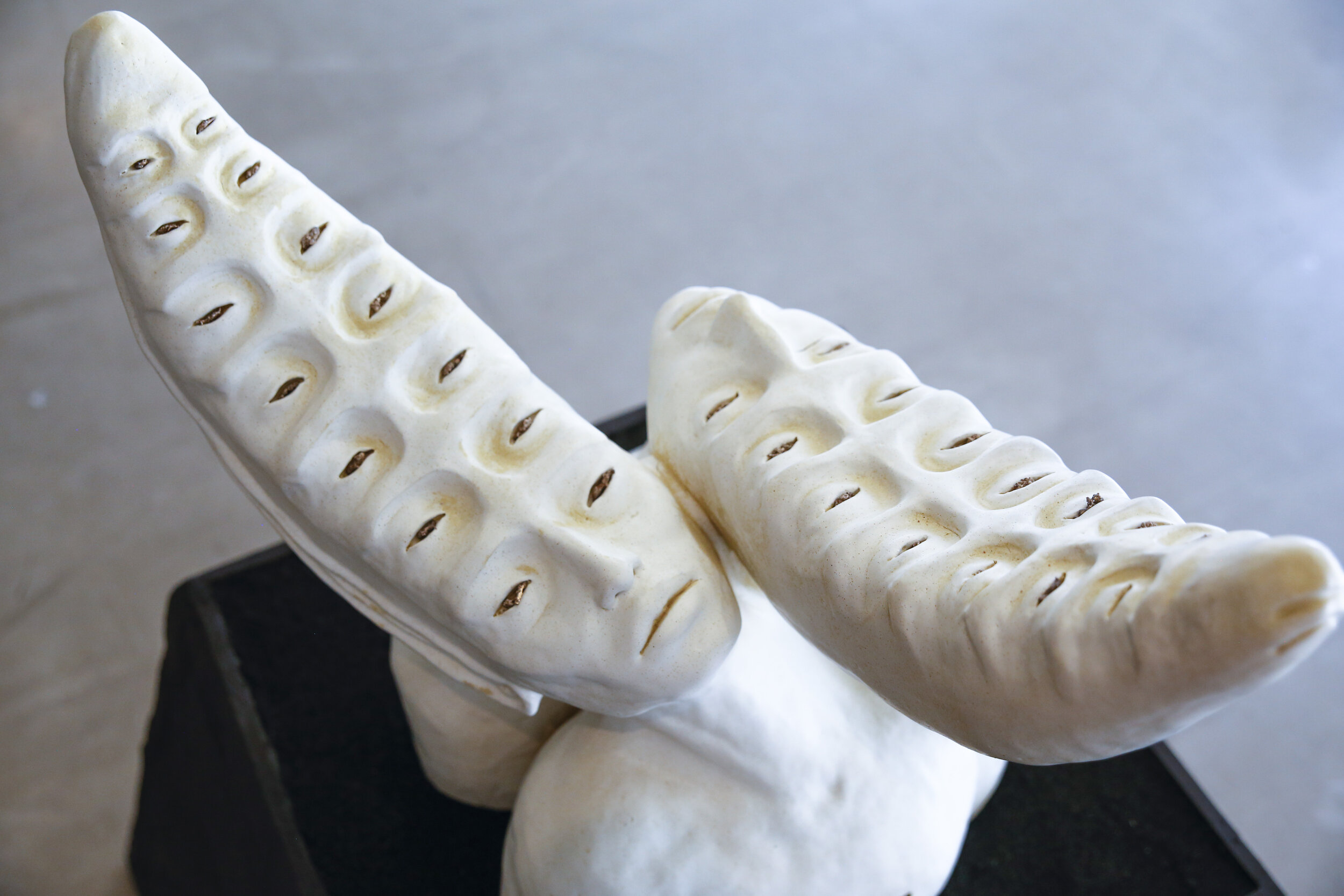
Daniel Robles Lizano
Daniel Robles Lizano’s small sculptures are molded by a taste for playful symbolism and expressive plastic form. They are the work of a storyteller, fascinated by myths and science and indifferent to the demands and techniques of the medium. His patient care for the features of animal life hones in on the accidental and unusual. A table piece like Craneo recalls Brancusi’s softly polished, tender heads — particular in their concentration on attributes and shapes over gestures and movement. But what is treated with naive delicacy is not the abstracted head of a beloved but a primitive, alien fantasy: a figure whose rounded eyes and unusual protuberances give an air of comic innocence. The shape of an eye, the curve of a nose, or the texture of skin is always in these pieces as calligraphic and decorative as they are descriptive — ornamental in the sense that ancient pottery is ornamental, happy and child-like. In Luna de los Tres Túneles, a secret cult is celebrated on behalf of an all-seeing creature. The rows of eyes and the moon-like face might intrigue some with their occultist meanings, but their allure is really in the intoxication of form, the force that compels you to imagine the natural body submissive to the laws of fancy and beauty. Modern art since Symbolism has always been attracted to the occult, notably as a way of detachment and despair towards change but also as a reaction to mere surfaces, a desire to dig deep. When the cloud of obscurantism blows away, we are left here with a host of characters playing their parts in everyday life — free, unconstrained, and effortless. They are thus untouched by fate and drama, prevented from passion and mystery. They are the products of a sudden spark of spirit, which, like in most Romantic sculpture, makes them fragmentary but also spontaneous and pleasing. These marionettes, plaster heads, body fragments, and reliefs are made of the stuff of dreams, and might offer less as “sculpture,” in the formalist sense, than as gifts for life. “The origin of sculpture,” wrote Baudelaire, “is lost in the darkness of time.” Its roots stem from a world of fetishes and wandering spirits. And only a true believer might still bring to light their tranquil magic with such a conviction of form.
This portfolio was originally featured in Issue 0.
(from top to bottom)
Esencias Efímeras, 2015, Various oils, glass bottles, acrylic, and water, 52 x 35 x 35 cm. Photo courtesy of the artist.
Mantis, 2017, Casted Bronze, 32 x 21 x 17 cm. Photo courtesy of the artist.
Untitled, 2019, Silicone, fiberglass, magnets, hair, and copper, 36 x 18 x 14 cm. Photo courtesy of the artist.
Ajolote Albino, 2019, Silicone prosthetic appliance for Yobs music video. Photo courtesy of the artist.
Luna de los Tres Túneles, 2018, Sand, ceramic, bronze, and concrete, 150 x 122 x 122 cm. Photo courtesy of the artist.
A polen sabía / su lengua antera. / La sangre savia / le recorría., 2019, Opal, rope, hydrostone, and pine wood, 61 x 39 x 23 cm. Photo courtesy of the artist.
Membrana, 2018, Bronze, silicone, and hair, 51 x 32 x 3 cm. Photo courtesy of the artist.
Reverberaciones, 2017, Mixed media, figures: 152 x 137 x 70 cm; video: 1m 59s. Video courtesy of the artist.
Daniel Robles Lizano is a Mexican artist based in Mexico City. He studied at the School of the Art Institute of Chicago where he got a BFA in sculpture. His current works focus on the use of ceramics and mold making processes as well as practical effects for film and performance. His current interest has been in masks as a vessel and extension of the self.
You can see more of Daniel’s work on his website and Instagram.
